Red Lobster, the storied seafood chain struggling through bankruptcy, has announced the closure of 23 more restaurants across the United States. This latest wave of closures will further reduce the chain's footprint, bringing its total number of outlets down to approximately 500-a significant drop from the 650 locations it boasted just a year ago.
The closures are part of Red Lobster's ongoing bankruptcy proceedings, which began earlier this year when the chain filed for Chapter 11 protection in May. The company's financial difficulties have been exacerbated by a combination of mismanagement, stiff competition, and broader economic pressures.
In a recent court filing, Red Lobster outlined the decision to reject leases for the additional locations, stating, "These restaurants are likely to continue to drive losses and are not anticipated to be necessary for the operation of our business moving forward." This strategic move aims to streamline operations and stabilize the company's financial footing.
The list of locations slated for closure includes a range of states from Arizona to Virginia, with notable closures in major cities such as New York, Florida, and California. The closures encompass both high-profile and smaller regional outlets, reflecting the chain's need to reassess its market presence and operational efficiency.
Red Lobster's financial woes have been a result of several factors. The company has faced increasing competition within the casual dining sector and rising operational costs. Mismanagement under previous ownership, particularly by Thai Union-a global seafood supplier that became Red Lobster's largest shareholder in 2020-has also contributed to the chain's struggles. Under Thai Union, Red Lobster implemented various cost-cutting measures and strategies that ultimately backfired, such as the ill-fated $20 endless shrimp promotion, which resulted in a reported $11 million loss.
The seafood chain's recent bankruptcy filings reveal a significant drop in customer traffic, with a 30% decline in guests since 2019. Additionally, the once-popular all-you-can-eat shrimp deal, which initially attracted patrons, became a financial burden and contributed to the company's downturn.
As part of its restructuring efforts, Red Lobster is undergoing a significant overhaul. Fortress Credit Corp., the lender facilitating Red Lobster's bankruptcy proceedings, has announced that it will be installing Damola Adamolekun, the former CEO of P.F. Chang's, as the new CEO of Red Lobster. Adamolekun, who left P.F. Chang's in August 2023, is expected to lead the chain through its post-bankruptcy recovery and strategic reformation.
The appointment of Adamolekun is seen as a critical step in Red Lobster's attempt to revitalize the brand and restore its financial health. Fortress Credit Corp. has also provided a substantial $100 million loan to support Red Lobster's operations during this turbulent period.
Despite the challenges, Red Lobster remains a significant player in the seafood restaurant industry. The chain's efforts to streamline operations and focus on core locations are intended to position it for future stability and growth. However, the path to recovery will be closely scrutinized by industry analysts and customers alike.






